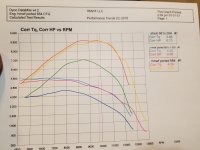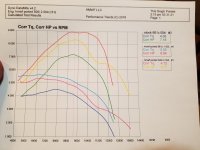- Local time
- 12:16 PM
- User ID
- 319
- Joined
- Dec 29, 2015
- Messages
- 9,614
- Reaction score
- 63,347
- Location
- Strong Island NY
Oh well, the troll had a bad attitude but some good points.
I think he was trying to say that an engine optimized for running on higher octane fuel could make more power than a low octane designed motor.
Octane is the relative speed at which a fuel will burn as compared with 100% hydrocarbon. The longer the Hydrocarbon chains in the fuel, the slower it will burn. It does burn slower, so it needs more advance to have time to fully burn. The slow burn means it’s less likely to pre-ignite (detonate) and fire before the piston can take advantage of the pressure change the combustion creates.
Full burn quickly creates the highest cylinder pressure and most efficient use of fuel, but we are limited by various factors (aka variables). Generally, the higher the number of carbon atoms in a fuel, the more total heat it will produce-more bonds need to be broken for the oxidative/reduction process. But it takes longer, so we are looking for the quickest pressure we can build in a cylinder perfectly at TDC.
Saw engines may not differ than other 2T engines by design, but there use in their powerband certainly does. Saws are meant to be used at WOT and really not in between. Because of this, they do tend to run hotter than other types of engines.
All compression does is preheat the fuel/air mix to the point where it’s just about to ignite so that it can have the most time to burn before the burn is useless (won’t add cylinder pressure that’s meaningful). So higher octane fuels can be compressed more, generally contain more hydrocarbons, and should make more heat per mole of substance if burned efficiently.
When a saw gets hot, it needs less compression and less advance to burn fuel efficiently. You’ve all heard a saw 4 stroke and then clean up in the cut. Once you ask a saw to do work, the cylinder temps go up and the saw suddenly can burn the fuel without misfire.
I see the “theory vs reality” argument here. But science is science and it’s truth are generally born out though-out time. It’s all physics. Remember Newton’s laws. Energy can neither be produced or destroyed, it only changes form. In an engine, we are converting potential energy in fuel into kinetic energy. Heat is the byproduct, so the more heat you lose, the less total power you are getting out of that fuel. The VE of a saw comes into play here as well. There are a lot of pumping losses, so a saw that’s 250psi while pulling the starter rope won’t come near that amount of static compression when the cylinder has a millisecond to fill at 14K.
So pretty much, by design, saws dont need high octane fuel to perform well. They need a fuel that’s compact in heat/ml that will create a lot of energy -like gasoline that burns at 14.9:1 stoichiometric ratio. The speed of the fuel burn plays a role when you’re running at WOT over 10k for nearly all of its run time. High octane fuel will just be wasted by not taking advantage of the full burn.
Think I confused myself. Hope this makes sense. I’d also be willing to toss in a few sheckles to see what Joe can prove on the dyno. My bet would be that there will be a negligible difference between high and low octane fuels.
I think he was trying to say that an engine optimized for running on higher octane fuel could make more power than a low octane designed motor.
Octane is the relative speed at which a fuel will burn as compared with 100% hydrocarbon. The longer the Hydrocarbon chains in the fuel, the slower it will burn. It does burn slower, so it needs more advance to have time to fully burn. The slow burn means it’s less likely to pre-ignite (detonate) and fire before the piston can take advantage of the pressure change the combustion creates.
Full burn quickly creates the highest cylinder pressure and most efficient use of fuel, but we are limited by various factors (aka variables). Generally, the higher the number of carbon atoms in a fuel, the more total heat it will produce-more bonds need to be broken for the oxidative/reduction process. But it takes longer, so we are looking for the quickest pressure we can build in a cylinder perfectly at TDC.
Saw engines may not differ than other 2T engines by design, but there use in their powerband certainly does. Saws are meant to be used at WOT and really not in between. Because of this, they do tend to run hotter than other types of engines.
All compression does is preheat the fuel/air mix to the point where it’s just about to ignite so that it can have the most time to burn before the burn is useless (won’t add cylinder pressure that’s meaningful). So higher octane fuels can be compressed more, generally contain more hydrocarbons, and should make more heat per mole of substance if burned efficiently.
When a saw gets hot, it needs less compression and less advance to burn fuel efficiently. You’ve all heard a saw 4 stroke and then clean up in the cut. Once you ask a saw to do work, the cylinder temps go up and the saw suddenly can burn the fuel without misfire.
I see the “theory vs reality” argument here. But science is science and it’s truth are generally born out though-out time. It’s all physics. Remember Newton’s laws. Energy can neither be produced or destroyed, it only changes form. In an engine, we are converting potential energy in fuel into kinetic energy. Heat is the byproduct, so the more heat you lose, the less total power you are getting out of that fuel. The VE of a saw comes into play here as well. There are a lot of pumping losses, so a saw that’s 250psi while pulling the starter rope won’t come near that amount of static compression when the cylinder has a millisecond to fill at 14K.
So pretty much, by design, saws dont need high octane fuel to perform well. They need a fuel that’s compact in heat/ml that will create a lot of energy -like gasoline that burns at 14.9:1 stoichiometric ratio. The speed of the fuel burn plays a role when you’re running at WOT over 10k for nearly all of its run time. High octane fuel will just be wasted by not taking advantage of the full burn.
Think I confused myself. Hope this makes sense. I’d also be willing to toss in a few sheckles to see what Joe can prove on the dyno. My bet would be that there will be a negligible difference between high and low octane fuels.
Last edited:











